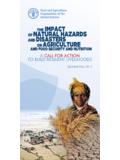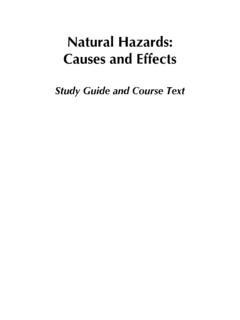Transcription of Kenya Natural Disaster Profile - Meteorology UON
1 Kenya Natural Disaster Profile United Nations Development Program Enhanced Security Unit Foreword Natural disasters disrupt people s lives through displacements, destruction of livelihoods and property, deaths and injuries. Consequently they take back years of development thus posing a major challenge to the achievement of the Millennium Development Goals especially the target of halving extreme poverty by 2015. The cyclic nature of Natural disasters in Kenya have constantly eroded the recovery capacity of communities especially in the ASAL districts hence affecting their economic development year in year out.
2 This requires more vigorous attention and planning to mitigate the effects as they have impacted greatly on the country s fight against poverty and efforts to reduce the number of people living below the poverty line. The economic cost of the impact of floods, droughts and landslides in the past have been estimated in millions of shillings. The Kenya Natural Hazard Profile provides an overview of the past and current Natural hazards that affect the country. The impact of such hazards is compounded by poverty and lack of adequate resources to develop the affected areas rendering the populations more vulnerable. The report highlights on the need to take up a proactive strategy in the management of Natural disasters in Kenya , which would improve the coping capacity of communities, lessen the impact and therefore improve the lives of Kenyans in the areas prone to harsh weather conditions.
3 A clear vision for future actions is inevitably necessary to set the pace for development programmes aimed at mitigating the impact of Natural hazards . UNDP is committed to working with the government of Kenya in improving the lives of communities in Kenya and our hope is that this report will generate a renewed interest in this critical development aspect and serve to bring together stakeholders to map out a new planning strategy and policy dialogue in the country. Paul Andre de la Porte Resident Representative United Nations Development Programme Acknowledgements The successful completion of the Kenya Natural Hazard Profile is highly accorded to the UNDP Kenya Country Office Enhanced Security Unit.
4 The team, under the leadership of the Assistant Resident Representative Elly Oduol, participated fully in provision of materials, information and expertise and several hours of their working time to contribute to the compilation of the report. The team also exhibited high commitment and participated actively in reviewing the report to ensure that it was of a high standard and valuable to the Kenyan society and other stakeholders. Our special thanks also go to the UNDP Resident Representative and UN Resident Coordinator Paul Andre de la Porte who facilitated the writing of this report by providing all the necessary information, materials, space and financial support.
5 Our sincere appreciation is extended to the Arid Lands Resource Management Project (ALRMP) at the Office of the president and the World Food Programme who also assisted in provision of information concerning their program work, monthly bulletins and their findings in the country related to Natural hazards in Kenya . Table of Contents Foreword ..i Table of contents ..iii List of tables ..iv Definition of key terms ..1 General information ..3 Background on hazards in Kenya ..4 Drought Background ..6 Location: Areas Prone to drought in Chronology of drought incidences in Kenya ..8 Drought intensity and probability of Existence and degree of Vulnerability.
6 13 Economic and social impact of drought in Kenya ..16 Local coping mechanisms ..18 Issues increasing vulnerability to drought in Floods Background ..26 Location: Areas affected Prone to floods in Kenya ..28 Economic and social impacts ..29 Issues increasing vulnerability to Drainage Basins in Local coping mechanisms ..36 Landslides Background on Landslides in Kenya ..37 Location: areas affected by landslides in Kenya ..38 Factors contributing to vulnerability to landslides in Kenya ..39 Economic and social impacts of landslides in Kenya ..39 Local Coping mechanisms in Kenya ..41 List of Tables and Figures Table 1 Recent History of Disasters in Table 2 ASAL districts classified by extent of Table 3 Chronology of drought incidences in Kenya since Table 4 Districts commonly affected by drought in Table 5 Forest Fire occurrences Table 6 Drought risk Identification Table 7 Areas affected by floods in Table 8 Recent history of floods in Kenya .
7 26 Table 9 Table of hydrological characteristics of drainage Table 10: Areas affected by landslides in Figure 1 Drought Flow Chart showing vulnerability ..15 Figure 2 Flood schematic diagram showing List of Acronyms ASAL Arid and Semi- Arid Lands NADIMA National Disaster Management Agency PRSP Poverty Reduction Strategy Paper. DCMN Drought Monitoring Centre Nairobi KMD Kenya Meteorological Department NEMA National Environment Management Authority ISDR International Strategy for Disaster Reduction FAO Food and Agriculture Organization ALRMP Arid Lands Resource Management Project FEWSNET Famine Early Warning System Network DRSR Department of Resource Survey and Remote Sensing UNFPA United Nations Population Fund KFSM Kenya Food Security Meeting KFSSG Kenya Food Security Steering Group PRSP Poverty Reduction Strategy Paper ERS Economic Recovery Strategy UNDP United Nations
8 Development Programme Kenya Natural Hazard Profile Definition of key terms Hazard A potentially damaging physical event, human activity or phenomenon with a potential to cause loss of life or injury, property damage, social and economic disruption of life, environmental degradation among other effects1. Vulnerability Vulnerability refers to a set of conditions resulting from physical, social, economic and environmental factors, which increase the susceptibility of a community to the impact of disasters. Vulnerability also refers to the characteristics of a person or group in terms of their capacity to anticipate, cope with, resist and recover from the impact of a Natural hazard2.
9 Disaster A Disaster can be defined as a serious disruption of the functioning of the society causing widespread human, material or environmental damage and losses which exceed the ability of the affected community to cope using their own resources3. Risk Risk is the probability of harmful consequences or loss resulting from the interaction between Natural hazards and vulnerable conditions of property and people4. Mitigation Short and long-term actions, programmes or policies implemented in advance of a Natural hazard or in its early stages, to reduce the degree of risk to the people, property, and productivity capacity5.
10 1 ISDR (2002); Living with Risk, A global Review of Disaster Reduction Initiatives, Preliminary version, pp 24-25. Geneva, Switzerland. 2 Ibid 3 ibid 4 ibid 5 ibid Preparedness6 Pre- Disaster activities designed to increase the level of readiness or improve operational capabilities for responding to an emergency. Response Actions taken immediately before, during or directly after a Disaster to reduce impacts and improve recovery. Impacts Specific effects of hazards or disasters also referred to as consequences or outcomes. Drought 7 Can be described as the naturally occurring phenomenon that exists when precipitation has been significantly below normal recorded levels causing a serious hydrological imbalance that adversely affects land resource production Meteorological drought9 Refers to a reduction in rainfall over a specific period of time, for example a day, month, season or year.









